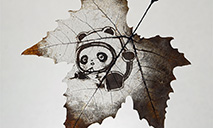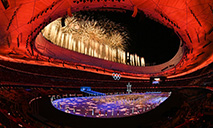What makes 2022 Winter Olympics uniquely Chinese?
BEIJING, Feb. 25 (Xinhua) -- Jackline Mukaragye found it very hard to buy a Bing Dwen Dwen - the mascot for the Beijing 2022 Olympic Winter Games.
Discussing the long queues outside souvenir stores and "out of stock" signs at online shops, the 23-year-old student from Rwanda said she totally understands people's affection for the chubby panda figurine in a suit of ice and Shuey Rhon Rhon - the fluffy red lantern-shaped Paralympic mascot.
"They are so Chinese," said Mukaragye, who was especially fond of the latter. "Red is the color of China and Spring Festival. It is a color of good luck."
The mascots are just one example of traditional Chinese culture being embodied at the 2022 Winter Olympics. In fact, from the opening ceremony to various competition venues, the sporting gala once again presents Chinese culture to the world.
FROM SOLAR TERMS TO TIGER-HEAD HATS
Ally Abdi Khamisi, a vocational school student from Tanzania, watched the opening ceremony in his dormitory in north China's Hebei province. He told Xinhua that he was impressed by the short video about 24 solar terms.
The 2022 Winter Games opened on February 4, just four days after the Chinese New Year. The start of the Games also marked Li Chun, the first solar term on Chinese calendar which means the beginning of spring.
During the countdown to the ceremony, names of the 24 solar terms appeared on big screens, with beautiful pictures and matching classic poems. It was followed by a firework show which formed two Chinese characters "Li Chun" in the night sky, as well as the English word "Spring".
"It was fascinating," said Khamisi, 25, who is currently learning Tai Chi. "It is an important part of Chinese culture to emphasize the harmony between nature and human beings."
As athletes entered the stadium, placards bearing names of all competing delegations in the shape of snowflakes grabbed viewers' attention. The design of the placards was inspired by the "Chinese knot," an ancient craft of hand knitting, symbolizing solidarity and prosperity.
The moment when the 24th Olympic Winter Games was declared open, a thundering canopy of fireworks in the shape of the "Guest-Greeting Pine" appeared above the Bird's Nest. The "Guest-Greeting Pine" on Mount Huangshan, a world heritage site in east China's Anhui Province, is recognized as a symbol of friendship and peace which can be seen in the Great Hall of the People on Tiananmen Square as well as at ordinary train stations and restaurants.
Khamisi also liked the performers' costumes at the opening ceremony.
The hats of the ushers holding placards were of traditional tiger-head design, as 2022 is the Year of the Tiger in China. A choir of 44 primary school students, whose jackets and boots also featured tiger elements, sang the Olympic Anthem in Greek.
"The children were like little tiger cubs, vigorous and adorable," said Khamisi. "They were singing in Greek. [The juxtaposition] is fantastic."
GREAT WALL AND LUCKY CHARM FOR ATHLETES
Architecture and culture are closely related to each other. Ancient Chinese architecture, such as temples, imperial palaces, official residences and folk houses, all display the profound influence of Chinese culture. The Beijing 2022 venues are no exceptions.
In Zhangjiakou, the world's best snowboarders rode on a course that included replicas of the Great Wall of China. The course makers built a block-by-block structure at the top of the slopestyle course as a tribute to China's iconic monument. A house with sloping roofs also featured in what looked like a traditional brush painting.
When the athletes whizzed on the rooftop of the house and flew over the snow-made 'Great Wall', they appeared to be like ancient swordsmen in a Chinese novel.
"I think the design has special characteristics. For us riders, when we compete on the 'beacon tower', it is also great fun," said China's Su Yiming.
The view was shared by Zoi Sadowski-Synnott, women's snowboard slopestyle gold medalist from New Zealand. "The course is pretty amazing. There's an amazing piece of snow artwork of the Great Wall. I've never seen anything like it. They've really outdone themselves," she said.
The National Ski Jumping Center in Zhangjiakou is nicknamed 'Snow Ruyi' because of its resemblance to the shape of a Ruyi, a traditional Chinese ornament symbolizing good luck.
Ruyi, which means "as you wish" in Chinese, has a long handle and a head usually in the shape of a heart, a cloud or a reishi.
Chief designer Zhang Li was so proud of his team's idea. "In terms of making use of the terrain, the 'Snow Ruyi' design is a good example," said Zhang.
The Big Air Shougang, a venue designed for big air events, has been affectionately called "Snowy Flying Apsaras" because the design of the slope looks like a ribbon of the apsaras, a typical dancing image on the murals from Dunhuang's Mogao Grottoes in northwest China's Gansu Province.
Mukaragye, who visited Dunhang four years ago, said that she was deeply impressed by the inspirational design.
"I was surprised to see that beauty of the curves was created with iron and steel. It was just incredible," she told Xinhua.
SINCERITY AND HOSPITALITY: INVISIBLE CHINESE CULTURE
Mukaragye noted that apart from elements that could be easily discerned in the Winter Olympics, Chinese culture was also felt in an invisible way.
"It is a distinct feature of the Chinese people to always prepare carefully and present the best things to the guests, always being sincere and never letting people down," she said.
Hosting the Winter Olympics is not solely the job of the Chinese government, she added. "My Chinese friends and classmates are all happy and proud. This is Chinese culture. You can't see it, but you can feel it."
The passion of the Chinese people was indeed felt by athletes coming to the Winter Olympics.
Tessa Maud, an 18-year-old snowboarder from the United States, was emotional when she recalled being warmly greeted by a Chinese volunteer who waved at them at the opening ceremony when their team marched into the National Stadium. She filmed that moment and replayed it again and again.
"I was crying because it was the cutest thing ever, and that moment was just so crazy, like a feeling I've never experienced," she said in a vlog she posted on Tiktok.
"That guy who said 'welcome to China' literally makes me tear up every time because they're so nice. All the volunteers are so sweet and so kind. They're just so happy that we're here. We feel so welcomed," she continued in a choked voice.
Maud soon received a letter from Sun Zeyu, a student from Tsinghua University and the volunteer in her video. Sun wished her to achieve the best results in Beijing and invited her to visit China again sometime after the COVID-19 pandemic so that he could show her around, and say "Welcome to China" again without a face mask.
Many Chinese web users left their comments for the heart-warming story. "The hospitality is deep in the genes of the Chinese people," said a person nicknamed Guozi.
"You can always trust the kindness and warmth of the Chinese people," another one said.
Photos
Related Stories
- IOC member hails Beijing Winter Olympics as "very successful"
- Interview: Beijing Winter Olympics "a success," says Malian Olympic official
- Beijing 2022 Main Media Center in transition to serve Winter Paralympics
- China to deliver successful Winter Paralympics as Olympics: IPC president
- Beijing 2022 in the eyes of world Olympians
Copyright © 2022 People's Daily Online. All Rights Reserved.










